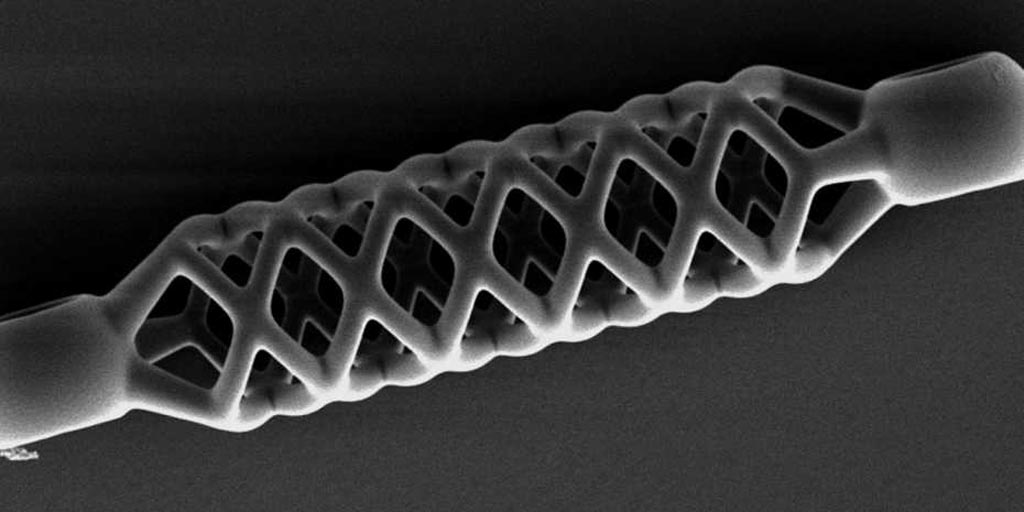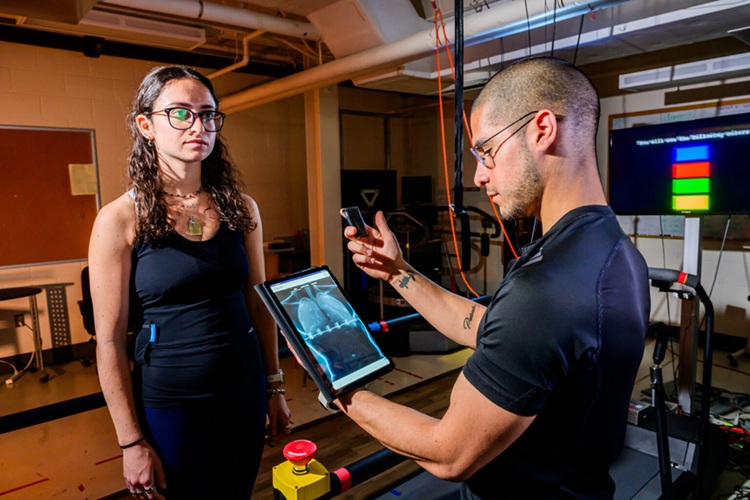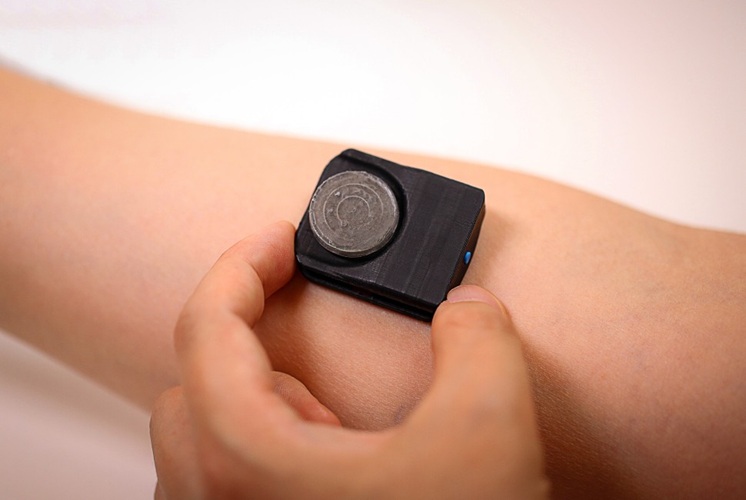Tiny Polymer Stent Could Treat Pediatric Urethral Strictures
|
By HospiMedica International staff writers Posted on 20 Aug 2019 |

Image: A 4D microstent just 50 micrometers wide and half a millimeter long could be used to help children with urinary tract defects (Photo courtesy of ETH Zurich).
A novel manufacturing technique can be used to fabricate stent-like microstructures with shape memory properties that are 40 times smaller than current stents.
Developed by researchers at the Swiss Federal Institute of Technology (ETH; Zurich, Switzerland), Politecnico di Milano (Italy), and Kantonnspital Aarau (Switzerland), the manufacturing process uses three-dimensional (3D) printed sacrificial high-resolution micro-molds that are produced by direct laser writing. The printed templates are then infused with polymers and set using ultraviolet (UV) light. The structure is then dissolved in a solvent bath, leading to a 3D printed microstructure that has shape memory properties.
The method was used to manufacture 3D stents with minimum features of 5 µm, which is 40 times smaller than those reported to date. The polymer provides the stent's shape-memory properties, which the researchers refer to as a fourth dimension (4D); even if the 3D construct is deformed, it remembers its original shape and returns to it when warm. The method can also be used to indirectly 3D and 4D soft microrobots constructed of gelatin helices filled with magnetic nanoparticles. The study describing the new manufacturing process was published on July 5, 2019, in Advanced Materials Technologies.
“We've printed the world's smallest stent with features that are 40 times smaller than any produced to date. Before human studies can be conducted to show whether they are suitable for helping children with congenital urinary tract defects, the stents must first be tested in animal models,” said lead author Carmela De Marco, PhD, of the ETH multi-scale robotics laboratory. “But the stents are still a long way from finding real-world application; however, the initial findings are promising. We firmly believe that our results can open the door to the development of new tools for minimally invasive surgery.”
Approximately one in every thousand children develops a urethral stricture, including in fetuses. If a stent could be inserted to widen the constriction while the fetus is still in the womb, life-threatening levels of urine that accumulate in the bladder could be avoided. But while stents are regularly used to treat blocked coronary vessels, the urinary tract in fetuses is much narrower in comparison.
Related Links:
Swiss Federal Institute of Technology
Politecnico di Milano
Kantonnspital Aarau
Developed by researchers at the Swiss Federal Institute of Technology (ETH; Zurich, Switzerland), Politecnico di Milano (Italy), and Kantonnspital Aarau (Switzerland), the manufacturing process uses three-dimensional (3D) printed sacrificial high-resolution micro-molds that are produced by direct laser writing. The printed templates are then infused with polymers and set using ultraviolet (UV) light. The structure is then dissolved in a solvent bath, leading to a 3D printed microstructure that has shape memory properties.
The method was used to manufacture 3D stents with minimum features of 5 µm, which is 40 times smaller than those reported to date. The polymer provides the stent's shape-memory properties, which the researchers refer to as a fourth dimension (4D); even if the 3D construct is deformed, it remembers its original shape and returns to it when warm. The method can also be used to indirectly 3D and 4D soft microrobots constructed of gelatin helices filled with magnetic nanoparticles. The study describing the new manufacturing process was published on July 5, 2019, in Advanced Materials Technologies.
“We've printed the world's smallest stent with features that are 40 times smaller than any produced to date. Before human studies can be conducted to show whether they are suitable for helping children with congenital urinary tract defects, the stents must first be tested in animal models,” said lead author Carmela De Marco, PhD, of the ETH multi-scale robotics laboratory. “But the stents are still a long way from finding real-world application; however, the initial findings are promising. We firmly believe that our results can open the door to the development of new tools for minimally invasive surgery.”
Approximately one in every thousand children develops a urethral stricture, including in fetuses. If a stent could be inserted to widen the constriction while the fetus is still in the womb, life-threatening levels of urine that accumulate in the bladder could be avoided. But while stents are regularly used to treat blocked coronary vessels, the urinary tract in fetuses is much narrower in comparison.
Related Links:
Swiss Federal Institute of Technology
Politecnico di Milano
Kantonnspital Aarau
Latest Health IT News
- Printable Molecule-Selective Nanoparticles Enable Mass Production of Wearable Biosensors
- Smartwatches Could Detect Congestive Heart Failure
- Versatile Smart Patch Combines Health Monitoring and Drug Delivery
- Machine Learning Model Improves Mortality Risk Prediction for Cardiac Surgery Patients
- Strategic Collaboration to Develop and Integrate Generative AI into Healthcare
- AI-Enabled Operating Rooms Solution Helps Hospitals Maximize Utilization and Unlock Capacity
- AI Predicts Pancreatic Cancer Three Years before Diagnosis from Patients’ Medical Records
- First Fully Autonomous Generative AI Personalized Medical Authorizations System Reduces Care Delay
- Electronic Health Records May Be Key to Improving Patient Care, Study Finds
- AI Trained for Specific Vocal Biomarkers Could Accurately Predict Coronary Artery Disease
Channels
Critical Care
view channel
Novel Intrabronchial Method Delivers Cell Therapies in Critically Ill Patients on External Lung Support
Until now, administering cell therapies to patients on extracorporeal membrane oxygenation (ECMO)—a life-support system typically used for severe lung failure—has been nearly impossible.... Read more
Generative AI Technology Detects Heart Disease Earlier Than Conventional Methods
Detecting heart dysfunction early using cost-effective and widely accessible tools like electrocardiograms (ECGs) and efficiently directing the right patients for more expensive imaging tests remains a... Read more
Wearable Technology Predicts Cardiovascular Risk by Continuously Monitoring Heart Rate Recovery
The heart's response to physical activity is a vital early indicator of changes in health, particularly in cardiovascular function and mortality. Extensive research has demonstrated a connection between... Read more
Wearable Health Monitoring Device Measures Gases Emitted from and Absorbed by Skin
The skin plays a vital role in protecting our body from external elements. A key component of this protective function is the skin barrier, which consists of tightly woven proteins and fats that help retain... Read moreSurgical Techniques
view channel
Intravascular Imaging for Guiding Stent Implantation Ensures Safer Stenting Procedures
Patients diagnosed with coronary artery disease, which is caused by plaque accumulation within the arteries leading to chest pain, shortness of breath, and potential heart attacks, frequently undergo percutaneous... Read more
World's First AI Surgical Guidance Platform Allows Surgeons to Measure Success in Real-Time
Surgeons have always faced challenges in measuring their progress toward surgical goals during procedures. Traditionally, obtaining measurements required stepping out of the sterile environment to perform... Read morePatient Care
view channel
Portable Biosensor Platform to Reduce Hospital-Acquired Infections
Approximately 4 million patients in the European Union acquire healthcare-associated infections (HAIs) or nosocomial infections each year, with around 37,000 deaths directly resulting from these infections,... Read moreFirst-Of-Its-Kind Portable Germicidal Light Technology Disinfects High-Touch Clinical Surfaces in Seconds
Reducing healthcare-acquired infections (HAIs) remains a pressing issue within global healthcare systems. In the United States alone, 1.7 million patients contract HAIs annually, leading to approximately... Read more
Surgical Capacity Optimization Solution Helps Hospitals Boost OR Utilization
An innovative solution has the capability to transform surgical capacity utilization by targeting the root cause of surgical block time inefficiencies. Fujitsu Limited’s (Tokyo, Japan) Surgical Capacity... Read more
Game-Changing Innovation in Surgical Instrument Sterilization Significantly Improves OR Throughput
A groundbreaking innovation enables hospitals to significantly improve instrument processing time and throughput in operating rooms (ORs) and sterile processing departments. Turbett Surgical, Inc.... Read moreBusiness
view channel
Expanded Collaboration to Transform OR Technology Through AI and Automation
The expansion of an existing collaboration between three leading companies aims to develop artificial intelligence (AI)-driven solutions for smart operating rooms with sophisticated monitoring and automation.... Read more















